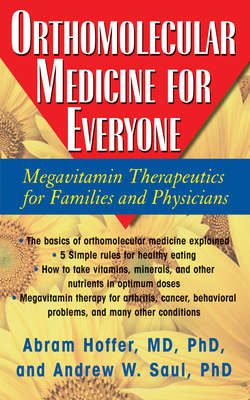Читать книгу Orthomolecular Medicine for Everyone - Abram Hoffer M.D. Ph.D. - Страница 62
На сайте Литреса книга снята с продажи.
POTENTIAL SIDE EFFECTS
ОглавлениеAny chemical used in treatment may have both negative and positive side effects. Positive or advantageous side effects are so rare they are seldom discussed in pharmacology. Toxicology deals only with negative effects. Nutrients, in sharp contrast, have a large number of beneficial effects that are unexpected and have not been considered. The reason is that nutrients are not used for symptomatic treatment only—they have a global effect on health. For example, vitamin B3 cures pellagra. One of the main, but not invariant, symptoms of pellagra is a typical skin rash, especially in areas exposed to the sun. A cured pellagrin has a positive side effect, which is cure of the skin rash. Using niacin to lower cholesterol levels will have a positive effect of decreasing the tendency for arteriosclerosis.
Negative side effects associated with niacin are the flush already described, nausea and occasionally vomiting, headache, excessive release of histamine, an effect on blood sugar tolerance, skin lesions, and liver problems.37
Nausea and Vomiting—Both niacinamide and niacin will cause nausea and vomiting if the dose is too high, but a few days are required before this side effect occurs. The first reaction is mild nausea. Later, it is more pronounced and, if the dose is not reduced, it will lead to vomiting. Excessive vomiting can cause dehydration and may be one of the factors in the etiology of liver disease when it does occur. Children may not know how to describe nausea and will simply lose their appetite. When nausea is present, the dose must be reduced, but this may lower the dose below its therapeutic level. If niacin causes nausea, one can change to niacinamide or from niacinamide to niacin, or subnauseant levels of both may be required (for example, 1,500 mg of niacin, plus 1,500 mg of niacinamide provides 3,000 mg of total vitamin B3). If neither form can be tolerated, one of the esters, such as Linodil or HexaNiacin, may be used. The nauseant effect can also be reduced or eliminated by using antihistamines and antinauseants. Tranquilizers have antihistamine properties and are also anti-nauseant and are helpful in controlling nausea.
Nausea induced by excessive vitamin B3 is nearly always gone within 24–48 hours after use is discontinued. This is the best way of determining whether the nausea is coming from the vitamin or from some physical illness. When vomiting has developed, it may require two days to clear. Adequate fluid intake, small amounts every hour, will prevent dehydration.
Headache—Headache is a rare side effect, especially of niacin, and it is probably related to the histamine-releasing properties of niacin. It is never severe, being usually a mild, prolonged tension headache that can be controlled by mild analgesics. Very rarely, the vitamin B3 has to be changed to a different form, such as niacinamide or inositol hexaniacinate.
Excessive Secretion of Stomach Acid—A few patients have experienced excessive secretion of gastric juices, perhaps because the histamine released by the niacin overstimulated gastric secretion.
Effect on Sugar Tolerance—Very soon after I (A. H.) began to study the clinical and physiological properties of vitamin B3, I found that it altered the sugar tolerance curves of a few people. When it did have an effect, it decreased sugar tolerance. It is necessary to discontinue the niacin for at least five days before doing a glucose tolerance test. There is no residual effect. Diabetics may be treated with niacin and, in most cases, it has no effect on insulin requirements. These changes are usually small and require minor dosage adjustments. Niacinamide has no effect on either glucose tolerance tests or on insulin requirements.
Skin Lesions—A very small proportion of patients, particularly schizophrenics, develop a dark pigmentation of skin when they are first treated with niacin, although niacinamide has no effect. The pigmentation comes on after several months, especially on some joint surfaces. There are no symptoms (itching or rashes) associated with it. This is not acanthosis nigricans (hyperpigmentation of the skin).
Liver Problems—Rarely, vitamin B3 will cause jaundice. In working with niacin for the past fifty years, I (A. H.) can recall fewer than five patients who developed jaundice. All recovered and one went back onto niacin with no recurrences. Many of the patients were alcoholics, who are more prone to jaundice. None died and some, it was discovered, were jaundiced from tranquilizers—when they were discontinued and the niacin retained, the jaundice cleared.
Many years ago, after the cholesterol-lowering effect of niacin was confirmed, some physicians became concerned because liver function tests showed dysfunction even though no jaundice was present. They took liver biopsies on a number of patients who had used 3,000 mg of niacin per day for one year. Histological examination with electron microscope revealed no evidence of liver dysfunction. Since then, many have noted that if the test is done while patients are taking niacin, the SGOT (serum glutamic oxaloacetic transaminase) and SGPT (serum glutamic pyruvic transaminase) will be elevated. It is my policy to ignore these findings unless there is clinical evidence of liver dysfunction. No liver function test is valid unless the patient has been off niacin for 5–7 days; if there is no jaundice, the tests will then be normal. Apparently, liver function tests remain normal if the dose of niacin is built up slowly.
It is likely that niacin interferes with the mechanics of the liver function test or else niacin has some effect in the liver that tends to exaggerate these effects. Thus, niacin increases bilirubin levels because it competes with bilirubin at the hepatic uptake level. It induces hyperbilirubinemia in patients with Gilbert’s syndrome. It might be a good idea to do routine bilirubin values before starting niacin to determine whether Gilbert’s syndrome patients are more apt to show abnormal liver function tests on niacin.
